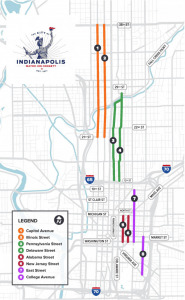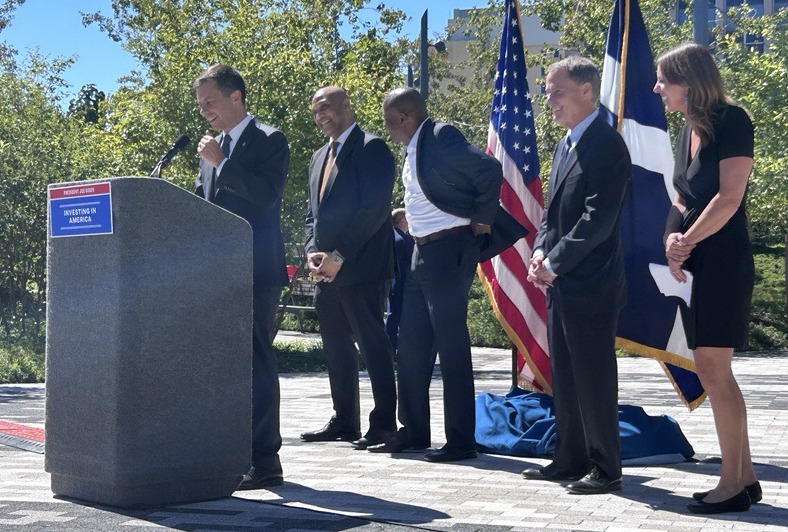Subscriber Benefit
As a subscriber you can listen to articles at work, in the car, or while you work out. Subscribe NowU.S. Transportation Secretary Pete Buttigieg spoke Thursday afternoon at Cummins Plaza in downtown Indianapolis, flanked by one-way streets that will be converted to two-ways under a recently announced $25 million federal grant.
Buttigieg, the former Democratic mayor of South Bend, touted spending from the U.S. Department of Transportation into his home state due to the $550 billion federal Bipartisan Infrastructure Law and gave kudos to fellow Democratic officials for helping secure the funding.

The main reason for Buttigieg’s visit was to discuss the Rebuilding American Infrastructure with Sustainability and Equity, or RAISE grant, which will be matched with just more than $20 million in city funds. A total of $46.5 million will be used to convert segments of eight one-way streets into two-way streets.
Buttigieg said the support of U.S. Rep. Andre Carson (who hosted Buttigieg on Thursday) and his colleagues—and some support from the other side of the aisle—helped pass the $2 billion grant program even after “the political obituary” had been written several times.
The Department of Transportation received about $15 billion in requests for about $2 billion in funding. Indianapolis being chosen “speaks to the quality of this project and the vision of this community,” Buttigieg said.
“This city has so much to be proud of under Mayor Hogsett’s leadership,” Buttigieg said of the Democratic mayor who faces a Republican challenger in his bid for a third term.
Buttigieg told IBJ that seeing “the continued growth and trajectory” of Indianapolis is rewarding, especially knowing that the Department of Transportation has contributed to it.
RAISE grant, pedestrian safety

In the 1960s, conversion of Indianapolis streets from two-way to one-way helped facilitate white flight from the urban core and into the suburbs, Indianapolis City-County Council Vop Osili said in written remarks. The one-way streets continue to serve “the needs of people who don’t live in neighborhoods that those streets traverse,” he added.
Osili said the grant will “allow us to revive neighborhoods along high-speed, high-traffic one-way streets.”
Studies say two-way streets tend to slow traffic while creating more direct routes, visibility and the opportunity for more commerce. In Louisville, one study reported a 60% decrease in collisions while another reported a 32% decrease in crime on the shifted streets.
In South Bend, the conversion of a pair of one-way streets to two-way streets spurred $90 million in new investment, Buttigieg said.
The eight one-way streets that will be converted in Indianapolis, he said, have seen more than 1,400 crashes in about three years. Those streets will be “modernized” to include bike lanes and sidewalk improvements as well as being converted.
The project is expected to go out to bid in 2026 and be completed in 2027.
Street design is part of what contributes to pedestrian and cyclist deaths, Buttigieg told IBJ. Indianapolis saw a record of 40 pedestrian deaths last year.
This is part of a “national crisis, a dramatic increase in roadway deaths,” he said. Roadway design changes, like the RAISE grant will fund, are part of the solution, but not the complete solution, he added.
“We need to have safer roads, safer speeds, safer drivers, safer vehicles and a higher standard of post-crash care,” Buttigieg said. “Those are the pillars of our national roadway safety strategy.”
There are sizable communities that have seen a year go by with zero roadway deaths, he added. “We want to add to the roster of communities that realized Vision Zero, and I know there’s a strong sentiment here to safety that we want to support.”
Mass transit investments
The U.S. Department of Transporation has recently given IndyGo, Indianapolis’ transit agency, $19 million to purchase diesel-electric hybrid buses and $33 million to fund a garage at the agency’s new East Campus headquarters.
IndyGo’s bus-rapid-transit lines have relied heavily on federal funding, with those funds making up half of the $370 million IndyGo predicts will be needed to build out the planned the Blue Line. Those investments are necessary to give workers and students mobility, Buttigieg said, and generally have a very good return.
“Now you still have to do it the right way and it, you know, requires a lot of careful work to maximize potential, but I see a lot of potential and what is happening here with the bus-rapid-transit effort,” he said. Buttigieg met earlier in the day with IndyGo CEO Inez Evans, IndyGo shared on social media.
He noted that bus rapid transit is dramatically cheaper than alternatives such as light rail or a subway system, and said cars are often out of reach or not available.
“We have lived too long with people having very few options,” he told IBJ.
Key Indiana Bipartisan Infrastructure Law investments
Earlier in the day, Buttigieg visited The Idle, a pocket park overlooking Interstate 65 and Interstate 70 near Fletcher Place and Fountain Square. Construction of the inner loop in the 1970s displaced 17,000 people.
“Standing in that remarkably creative Idle Park gave me a sense of how that affected the neighborhood and made me even more pleased that we are now partnering with community members here to do planning work to envision a different, better future through our Reconnecting Communities Program,” Buttigieg told attendees.
A $2 million grant announced in February will fund a study on the possibility of capping the recessed segments of Interstates 65 and 70 in the inner loop, near the Fletcher Place and Fountain Square neighborhoods. Capping refers to building a type of deck bridge on top of a roadway to create new surface area for development.
Even though the federal Reconnecting Communities grant is just a planning grant, Buttigieg said, it’ll support community work to find a shared vision for a possible future project. In 2021, Rethink Coalition and the Indy Chamber put together a $2.8 billion proposal to rebuild the highways partially underground.
Outside of Indianapolis, he pointed to a $1.6 million grant for Tell City that will allow the city to stabilize a crane at an Ohio River port and a $7 million grant to create an railroad overpass in Hammond, where images of children squeezing through dangerous blocked railroad crossings received national attention.
Please enable JavaScript to view this content.


Some of this will likely be invested in the stupid Blue Line and also free up the existing budget to add to the investment. What a waste of money. Tell us the ridership of the Red Line and the financial results.
Did you even read the story, or do you have another source that they’re stealing money from this grant to spend on buses instead?
People who rely on buses to get around the city would disagree that it’s “stupid.” The Blue Line would replace the Washington St route 8, which is the second-busiest route in terms of ridership behind, you guessed it, the Red Line. You can find ridership data, including the Red Line, publicly available at SAVI https://www.savi.org/2023/08/29/how-is-indianapolis-doing/.
Federal grants are non-fungible, unless they are discretionary (which this is not).
You are incorrect. Grants are specific and not interchangeable. Please check with the Federal Transit Administration. The funds for one-way conversion are for that project only. Funds for public transit buses are from a specific line item funding category. Grants for transit capital infrastructure, such as the Blue Line in Indianapolis, the Red Line rail heavy rail extension in Chicago, or the South Shore electric commuter rail extension to Munster in northwest Indiana are from a separate funding category available only after specific criteria are met. Furthermore for the Blue Line, federal capital funding had been set, but costs associated with drainage along the western segment of the alignment increased project cost, but the federal funding amount was set — and that meant any increases would have to be borne by the local agency; hence, IndyGo redefined the project to decrease capital cost but also to maintain federal requirements of at least 50 percent dedicated bus-only right-of-way.
Red Line ridership is available on the IndyGo website along with ridership for each route.
Financial details are also available from IndyGo. What specifically, regarding financial results is desired?
And if one desires to compare IndyGo operating statistics to those of other transit agencies, the information is readily available from the National Transit Database which contrasts operating costs, revenue and ridership for all agencies receiving federal funding. And all agencies must report operating data annually to continue receiving funding.
Lastlty, what specifically is stupid about the Blue Line — dedicated bus lanes and more frequent service and faster service and fewer stops service one of the busiest ridership corridors in the city?
Why do people who don’t even rid, let alone need the city bus, always have negative things to say about it? Every major city Indianapolis size and smaller has bus systems for their less fortunate citizens. Anderson Indiana even has a bus system, surely the state capital can get it right with its larger population.
“Street design is part of what contributes to pedestrian and cyclist deaths, Buttigieg told IBJ.”
Street design has, in almost all respects, IMPROVED over the last 10-20 years to respect pedestrians and cyclists. Yet the deaths rates, especially these last 3-4 years, keeps going up. Indianapolis saw its record last year. The city is far from great in terms of road design, but it’s better than it was in 1983 or even 2003.
The best street design isn’t going to matter a hill of beans if there’s not enforcement for drivers who violate traffic safety rules. Across the country, even in cities that are known for being pretty bike and pedestrian friendly, fatality rates are up–significantly so since COVID caused so many people’s brains to break. Meanwhile, a ped-friendly city like Philly has decided to scale back enforcement of speeding laws and other traffic violations because of “racial inequities”. Buttigieg has curried favor with activists who think enforcement should get the racial quota treatment.
If the race of the perpetrator matters more than the victims maimed and injured by reckless driving, do we really think you’re serious about minimizing fatalities, Mr. Buttigieg?
I’m always amazed when a self-described populist sides with the government that loves that statistically loves to punch down. You’d think he’d be on the side of “the people”.
Ever been in a car when the driver gets pulled over for a DWB, Lauren? It’s amazing how the attitude of the officer toward the driver softened when he realized it was a mixed race vehicle …
I guess I’m just a hypocrite, Joe. Oh well. Given that it is impossible for a human to build a 100% internally consistent moral framework, I’m in good company.
How many homeless people are you letting into your guest bedrooms? I’m not letting any. At least I’m honest about how wretched I think these people are. They’re filthy junkies and calling a spade a spade isn’t punching down. They made their own beds–they don’t operate in a vacuum of accountability, as much as you’d like them to. Lying to avoid hurt feelings is the paragon of cruelty. Real compassion is helping people from their brokenness by being honest with them, and not coddling them so they sink even further.
If your definition of “the people” includes those who voluntarily choose to become drug addicts, and your definition of “kindness” is to give them more resources so they can continue their depraved living, is it any wonder why it looks like urban areas are collapsing?
I’d much prefer not to side with using the government jackboot to take care of junkies, because, if people had basic moral standards, there would be no junkies. But we live in a fallen world where 100% of us are flawed, and the government defending the rights and livelihood of the sane, productive members of society instead of kowtowing to the lowlifes is part of how a certain select number of countries managed to cultivate a huge middle-class–something that was unheard of before the Industrial Revolution and still is in most developing countries, which have rich and poor and very little in the middle.
The Protestant work ethic was a major factor in helping countries achieve enviable standards of living. Equally important was a carefully defined notion of sin, for which the Catholic church was quite strong in articulating. Amazing to me how many people who grew up in this culture have replaced it with the religion of wokeness, and I marvel at how many more people will have to die in the name of ideology (ROWR! those racist officers pulling over one race more than others!).
Returning to the subject of street design–how many more tens of millions do you want us to spend while deluding ourselves about how little this will work if you don’t hold bad people accountable? Am I a jackboot for thinking reckless drivers should face serious penalties? They face much harsher penalties in Europe than they do here. In most of Europe, the speed cameras even track if they pass/overtake in the right lane (or left lane if its UK). Big fines. Drunk driving can put you in prison for a few years.
Why do you think certain races should be held to lower standards, Joe? Do you think they’re just not good enough?
Indianapolis is not Philadelphia. And aspects of street design and racial profiling are irrationally commingled in this back and forth. Please specifically cite and define “curried favors” — what does that mean. Be specific and cut the innuendo. Where in this article is racial inequality addressed and where — based on what data or statements or facts — has Buttigieg suggested that this be so. In Perhaps speeding too often was used as an excuse to disproportionately stop certain ethnic groups. The racial reference here is a bit of a red herring.
YES, speeding and other traffic violation should be enforced by law. But given the grave nature or homicides and other crime and limited availability of officers, one realizes that comprehensive enforcement of traffic may not rise to the top of the priority list. Given that, street design aspects, such as two-way travel, narrower lanes, and other treatments can slow traffic in an effort to reduce injuries and fatalities. In Indianapolis and Indiana for that matter, the historically low taxes and poor overall planning has resulted in unattractive cities — streetlight on wooden poles, wires zigzagging across streets, a lack of sidewalks, unpaved alleys — but this need not remain so.
Derek–
Here’s where Mayor Pete curried favors with the racial hustler extraordinaire:
https://www(dot)msnbc(dot)com/politicsnation/watch/secretary-buttigieg-highlights-the-disproportionate-impact-of-traffic-crashes-on-people-of-color-171032133652
You’re right, Indianapolis is not Philadelphia. In almost every metric, Philly is BETTER in terms of ped/bike safety. It still has trolleys! But they’re building racial quotas rather than simply looking at reckless driving on its own terms. Meaning they put “inclusion” and “unconscious bias” ahead of actually saving lives by punishing the real offenders.
Thankfully, one of the beauties of technological advancements is that automation and electronic traffic enforcement allows officers to concentrate on homicides and other serious crimes so they don’t have to devote as much manpower to petty citations and traffic enforcement. It also removes the possibility of officer bias; a machine doesn’t care about skin color. Yet this is STILL not good enough in places like Philly because an impartial tool for flagging offenders still reveals some subsets offend at disproportionate rates.
There’s much to applaud about converting one-way streets, of building safer shelters and better crosswalks. But we’ve been improving this stuff for years and yet traffic fatalities started surging since 2020. If an aquarium has a leak, it’s not going to save too many fish over the long haul if you keep dumping more water in from the top.
So you’re telling me that when police statistically pull over more people of color, it’s because people of color are just crappy drivers.
I’m all for holding people accountable. Just hold them equally accountable.
Joe–
I don’t think the vast majority of traffic cops are asking themselves, “How many colorful people can I pull over today?”
I think statistically that some races speed more regularly and drive recklessly than others. And the results play out accordingly.
Do you think the traffic cameras/monitors that ticket speeders by reading their license plates are biased?
This is great. The conversion of these streets back to two way is a huge investment in the neighborhoods and communities. We’ve already seen what a positive difference it makes on streets converted over the past few years. Thank you Indy City Planners and Transportation Planners.
This is a ridiculous: “In the 1960s, conversion of Indianapolis streets from two-way to one-way helped facilitate white flight from the urban core and into the suburbs, Indianapolis City-County Council Vop Osili said in written remarks.”
White flight, as well as Black and Brown flight, occurred because families wanted more space and better schools, not because of one-way streets which generally extended between downtown and 38th to the north and downtown and Emerson to the east. And,, the poorly planned interstates through the city excerbated “everybody-flight.”
Does the statement from the councilmember make sense?
Bingo! On this we can agree 100%. Talking around the issue and expecting people to take it at its face value. Very typical of a politician, and understandable…because many WILL take it at its face value.
Several counties and cities merged in the 1960’s. Indianapolis was the only one to leave schools out.
https://inschoolmatters.wordpress.com/2016/07/13/1961-decisions-shaped-indy-school-districts/